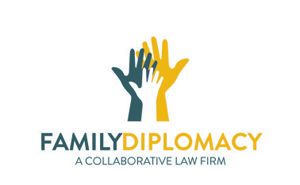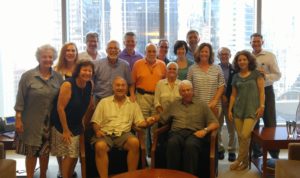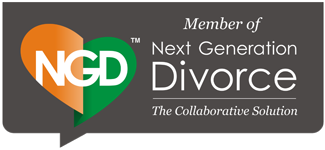Helping Divorce Lawyers Become Peacemakers
I am a collaborative family law attorney. I help families divorce privately and respectfully so that they can end their marriage but also begin their post-marriage life as peacefully as possible.
I am also a trainer. I train attorneys, mental health professionals, and financial professionals how to offer collaborative services to divorcing couples and others handling family law matters.
This past weekend I was in Chicago at a master class led by Forrest (Woody) Mosten on how to train in a way that lets divorce attorneys and others know that they can do well by doing good. Woody is a leading collaborative attorney and mediator, as well as a best-selling author out of Beverly Hills, California. He also happens to be a friend of mine, a mentor, and my co-author for an upcoming American Bar Association book on Building A Successful Collaborative Law Practice.
The class, which included 15 hand-selected attorneys and mental health professionals from around the U.S. and Canada, was described by Canadian social worker and media personality Gary Direnfeld as follows:
Woody Mosten is a world leader in mediation, practice and training. He is also a leader in providing training on how to be a trainer. Beyond his credentials experience and expertise, he is just a really nice guy.
As a really nice guy, Woody invited 15 people that included mental health professionals and family law lawyers, all of whom practice mediation and Collaborative Law to attend a free two day workshop in Chicago, July 2016. The opportunity was to train to be a trainer of his workshop, How to Build a Profitable Peacemaking Practice.
The goal of Woody’s peacemaking workshop is to encourage and promote other people to become successful peacemakers working with families in conflict, particularly separated couples and children living between two homes.
The goal of our workshop was to develop us as trainers of his workshop so as to create the conditions to train a greater number of successful peacemaking practitioners. If Woody has an agenda, it is to make the world a better place, particularly for separated parents and their children and to be able to earn a living doing so.
His invitation criteria was that the people invited all have taken or participated in co-leading his profitable peacemaking workshop. The other thing all the invitees had in common is that Woody considered the invitees to be top professionals in the field of peacemaking. I was included in his list of invited guests. I co-lead Woody’s Profitable Peacemaking Practice with him in Toronto, September 2015. I can’t speak to my professional status. I leave that to Woody and others.
Woody has a style that is remarkably engaging, warm and collaborative. While on the one hand he has a wealth of information to impart, on the other had he facilitates the input of all the participants to arrive at decisions as to what information may be most helpful to us. In other words, he walks the talk and his training style demonstrates attributes of peacemaking such as inclusion, acceptance and consensus building. Astonishingly, 15 participants under his guidance helped determine the content delivered by a master trainer to facilitate our learning needs. He obtained total buy in from the entire group.
As part of the training opportunity, Woody provided reading material in advance and also asked us each to prepare a ten minute presentation on any one of his many learning modules. To say there was reading material and preparations to be made is an understatement. As invitees, we had to arrive having already invested substantially in our own learning. Given we each would be presenting our learning module to a group of 15 other high level practitioners and trainers, you can imagine the pressure to perform was on. I think I can say with confidence we were all nervous to be judged by our peers and likely felt at least somewhat competitive in terms of our presentation.
Day one of the training the trainers workshop involved considerable group discussion facilitated by Woody as he also delivered substantial content on how to setup and deliver workshops. For every aspect of training Woody made it abundantly clear there were multiple approaches with no orthodoxy as to one approach being better than the other. In lieu, he challenged us to make decisions and discuss our decisions as to methods of organization and training and all with a view to consider the context in which the training was occurring and the learning needs of those in attendance. We had to think through everything.
Day two continued the training with each of us presenting a module from Woody’s long list of training modules. We were not only exposed to the content of his workshop then, but also 15 individual training styles. The exposure to 15 different training styles provided another profound learning experience. Between readings, PowerPoint, music, role plays, discussion and more, in one day we all were exposed to 15 different ways to facilitate the transfer of information.
Exposure to 15 different presentation styles is like going to a buffet of varied food, all of which is amazing. You get to taste, gorge, share, discuss and try so many different approaches to conveying information. You soon come to realize, one is no better than the other. Each presentation style has it’s own special place depending on the content you seek to deliver and the experience you are using to facilitate the delivery.
Along with the exposure to the 15 different styles of presentation Woody also had us take turns providing a critique of each others presentation. We learned not only how to present and how varied the teaching methods may be, but also how to deliver feedback extremely constructively and with a view to provoking greater learning and reflection. With each critique, we were supported in thinking about how our module fits within the broader workshop goals. Everything is purposeful.
Woody’s brilliance is that he can structure a learning experience with layer upon layer of learning. We were exposed to learning about content, process, approach and values both directly and subtly.
I think it was through the subtleties that the greatest learning took place. Those subtitles included Woody’s engaging, warm and collaborative style. This is not something that can be taught well by lecture or discussion. This is something to be taken in experientially.
This experiential part of the learning doesn’t translate into the content of the presentation, but rather it’s tone. This is the part that distinguishes a good presentation from one that is transformational.
What a remarkable experience and what a remarkable group of people I had the pleasure of meeting and learning with this past weekend. Everyone left their ego at the door. The environment was safe for learning, self-discovery, experimentation and reflection. Woody demonstrated how to create a place of higher learning.
My fellow attendees were:
-
Adam Cordover, Tampa, FL
-
Dona Cullen, Portland, OR
-
Brian Galbraith, Barrie, Ontario, Canada
-
David Hoffman, Boston, MA
-
Robert Merlin, Coral Gables, FL
-
Ken Neumann, New York, NY
-
Enid Miller Ponn, Weston, FL
-
Ron Ousky, Edina, MN
-
Nancy Retsinas, Vancouver, WA
-
carl Michael Rossi, Chicago, IL
-
Kevin Scudder, Seattle, WA
-
Melissa Sulkowski, Erie, PA
-
Zanita Zacks-Gabriel, Erie, PA
-
Kathleen Zumpano, Portland, OR
If you are looking for a private, respectful way to handle your family law matter and would like to schedule a consultation, or if you a family law professional or practice group leader looking to schedule a basic or advanced collaborative law training, contact Family Diplomacy: A Collaborative Law Firm at (813) 443-0615 or CLICK HERE to fill out our contact form.



Leave a Reply
Want to join the discussion?Feel free to contribute!